Chances are you already know that cattails are a survivalist’s godsend. In addition to providing water, food, shelter, and fuel, cattails also have anesthetic properties.
Directly applying the gel produces an amazing numbing sensation in the affected area. To this end, boils, blisters, and sores benefit greatly from this application.
The healing properties of cattail gel are:
- Astringent
- Coagulant (stops blood flow)
- Pain relief
- Antiseptic
In essence, cattail numbing gel works in two ways: first and foremost, the excretions from the leaf base clean the wound. Secondly, pain is addressed, providing immediate relief.
Surprise injuries without a first aid kit in an emergency situation are nobody’s idea of a good time.
In fact, emergency situations seem to be the times in which we are least prepared, but with a little knowledge and foresight, you can take care of a nasty gash in a pinch. The area between the young leaves near the root ball produces a jelly that doesn’t need any preparation at all in order to be useful.
In addition to administering immediately to pain or bleeding caused by wounds in the great outdoors, you can also make your own ointment in a jar to keep on hand.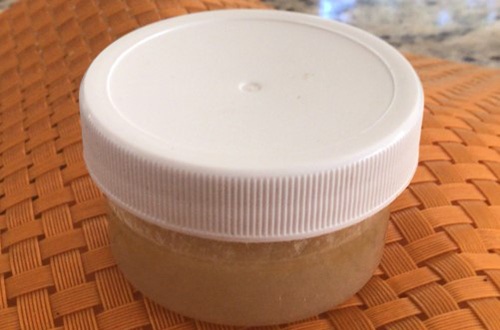
Jarring cattail numbing gel makes for an extremely useful home remedy. For home herbalists who already create tinctures, this analgesic preparation is a perfect addition to the repertoire.
Scraped off gel is decocted into a small pot and extracted by boiling it, and then simmering. After that, squeeze the pulpy mass to harvest all of the gel, and then boil again (with a bit more water).
The only tools required are resourcefulness, a putty knife or spatula, sesame oil, a pot and a stove, a sieve or cheesecloth, and a sterilized jar.
Harvesting The Cattails
Luckily, cattails abound in the most unlikely of places—anywhere that water collects, actually.
Related: Delicious Recipes Using Cattails – “The Supermarket of the Swamp”
If you don’t have them growing on your property or know where to find them, the best place to begin searching is on a neighborhood social media page. You’d be surprised how many other preppers there are out there and how many people are genuinely interested.
Within hours of my post, I had three responses. Two mentioned a public place near a four-way stop next to a strip mall. Although I was hesitant to start there, I hopped to it in rain boots just in case nobody wanted a perfect stranger stalking through their marshy areas.
An abundance of new shoots in clear water greeted me, and I had no problem whatsoever harvesting the spoils.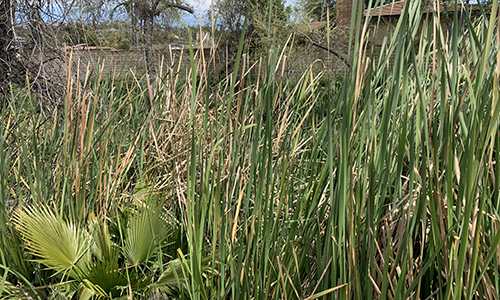
What To Look For And How To Harvest Correctly
My main concern was the toxin filtering function properties of cattails. Much like the beloved ginkgo tree lining city streets, cattails literally consume pollutants.
Especially since the marsh was so close to the road, I worried I might have toxic cattails on hand that wouldn’t work, or worse, induce an allergic reaction.
Related: How to Treat Allergies Naturally This Spring
Due to the clear quality of the water, I decided the risk was minimal.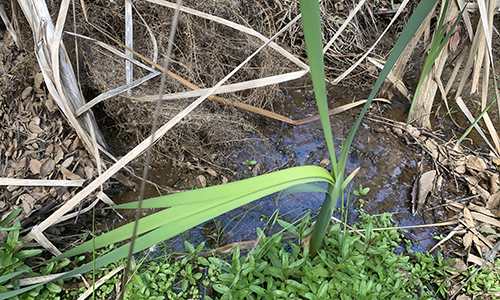
Another good indicator is the presence of insects. Because new shoots excrete gel closest to the root bulb in the water, the best place to cut is as close to the water line as possible.
It turns out that ants, in particular, are drawn to the gel and eat it. Ultimately, the presence of ants on a new shoot certainly signifies the mother lode. Just like in gardening, shake off the produce to get rid of the bugs.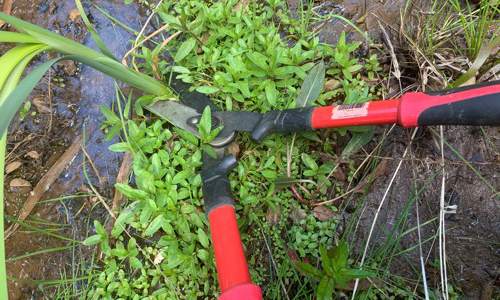
Because of my concerns about toxins, I also ended up checking out a neighbor’s stash. Nestled in high desert foothills, Tommy’s little marsh afforded me the perfect amount of privacy.
How To Make The Numbing Gel
Right there on the spot, I took a serrated putty knife to a recently cut shoot oozing gel from the base.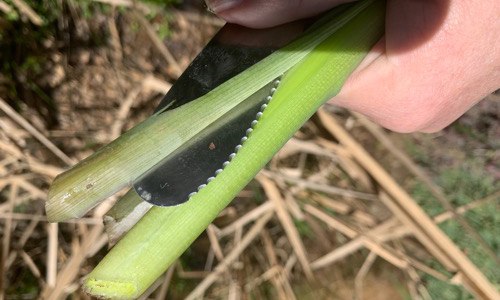
Previously, on a YouTube video, a fellow actually placed the gel in his mouth to help fight a toothache, claiming that it worked.
With just a little effort, I managed to procure enough to apply to a wound on my forehead that was in a lot of pain. A numbing sensation similar to lidocaine took immediate effect.
All in all, a large bowl worth of shoots is exactly the right amount for producing a small jar of ointment.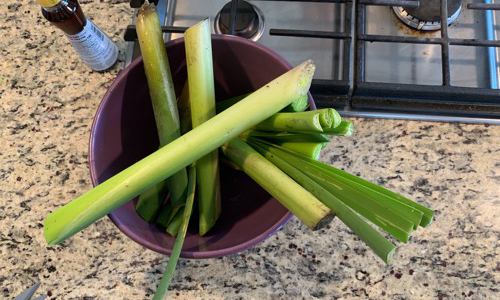
Excited, I grabbed my haul plus a dozen chicken (and quail!) eggs from Tommy and his toddlers. They loved hearing about how and why I was up to harvesting their weeds and they said they’d look into it further themselves.
On The Stovetop Is Where The Magic Happens
Once the shoots have been correctly harvested, the process of making the pain ointment is easy. Similar to green onions, the potency is at the base, so first, trim off any extraneous parts.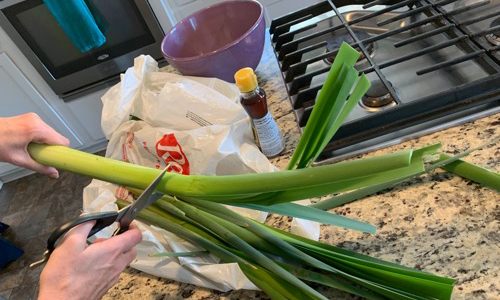
Clean and cut the stem base, then open the shoot up by splitting it with a knife.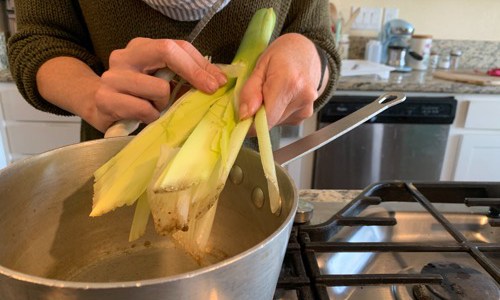
The best leaves resemble celery in the sense that they have a crosshatch pattern all along them. Leaves with a styrofoam-like texture contain the most jelly.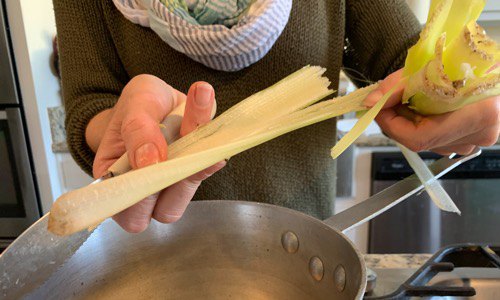
Scrape as much as you can off of these.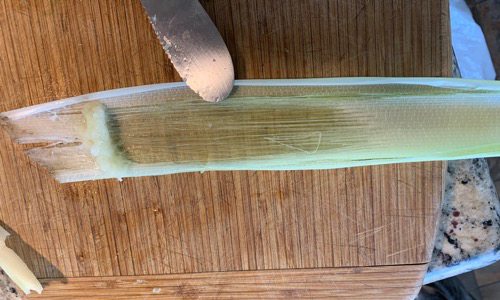
Carefully put as many of the gel-producing parts in a small pot.
The attached fibers are ok since they can be boiled down further.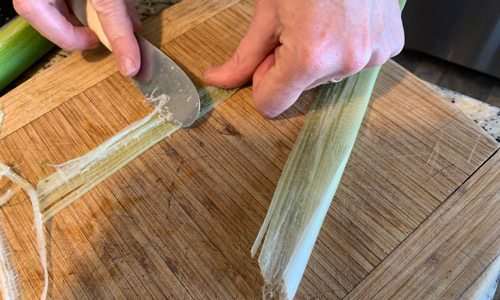
Once you’ve procured as much gel as possible, add about a quarter cup of water and a teaspoon of sesame oil. Sesame oil contains antibacterial properties, which naturally preserves the anesthetic.
Boil the mixture for five minutes, then simmer for 25 more minutes.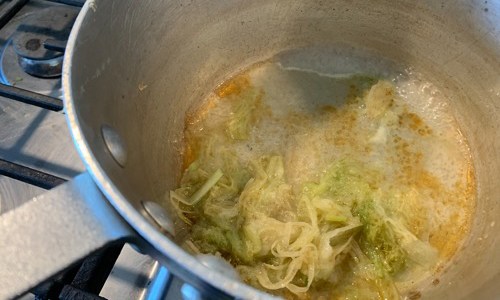
Squeeze all the matter you can over a sieve, collecting the good stuff from the underside.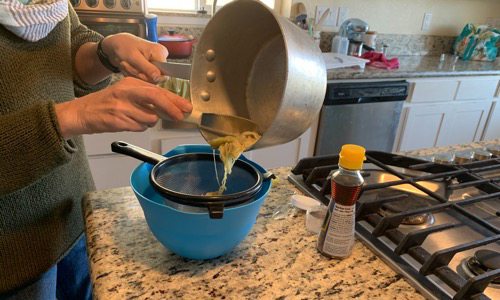
Cheesecloth is very useful in this application if you have it.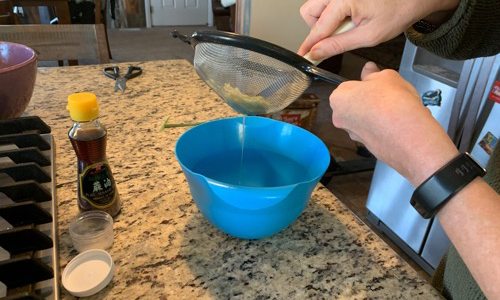
Return the squeezed out the pulp and repeat the process in order to obtain the most matter possible. (Just a little extra water added)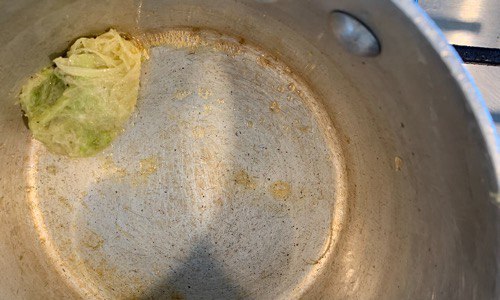 Next, strain the remaining matter into your vessel of choice.
Next, strain the remaining matter into your vessel of choice.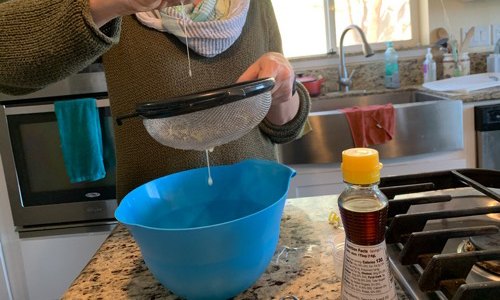
Now you should have about 2-3 ounces of sesame-smelling cattail ointment that works wonderfully.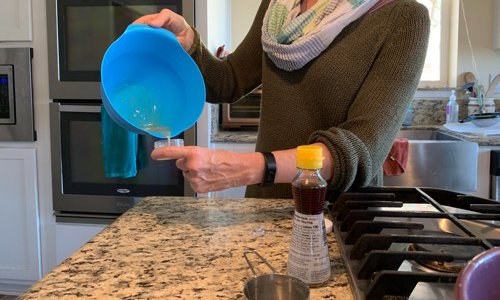
Because this is homemade and sesame oil isn’t the strongest preservative, we recommend either storing it in the refrigerator (or freezer) for up to six months.
Alternatively, you may can the product if you wish and that would most definitely add months to the shelf life.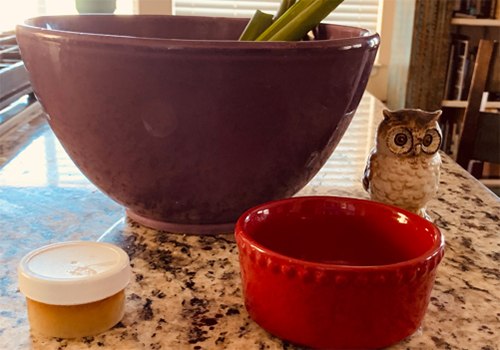
Use a cotton swab when applying the gel to clean skin as well. Open containers can easily hold bacteria from unclean fingers. Of course, common sense dictates best medicinal practices always involve clean hands.
As with any medicinal plants, people may experience allergies. If a rash or hive occurs, discontinue use right away.
Since I’ve made this ointment, I’ve used it more frequently than Neosporin to heal my scar and have applied it to a few blisters from a burn. The antiseptic properties combined with the numbing/healing are truly amazing.
Let us know if you make this DIY cattail anesthetic gel. We’d like to hear your stories.
You may also like:
 This Survival Shotgun Can Fire 8 Different Calibers and It Fits in Your B.O.B.
This Survival Shotgun Can Fire 8 Different Calibers and It Fits in Your B.O.B.
The Wild Plant That You Can Pop, Just like Popcorn (Video)
13 On-Screen Survival Lessons that Will Get You Killed

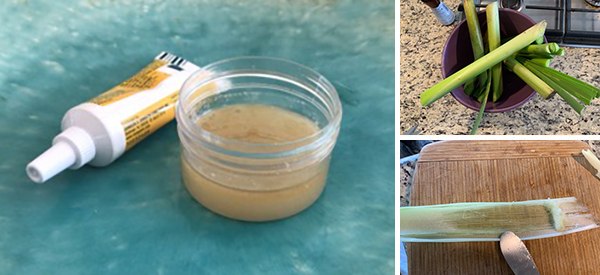













Good info in the article. Just curious. If the cattail has all of those properties, in, antiseptis analgesic, etc when you harvest, why do ya need to do all the other to keep in fridge ? Couldn’t ya just harvest the stalk and put that piece in fridge Nd use as needed? Maybe I missed something.
I did think it was a good article.
Thanks for writing it.
I tried that. The gel turns thin and disappears with storage over 2 days
Yes a good article that explains how to gather and use the gel.
How about using coconut oil instead?
Doesn’t go rancid and also disinfects.
Obviously, the readers making these comments aren’t taking into consideration that you are writing this article to provide information for a possible SHTF situation. “Fridge?” “Coconut oil”? C’mon, people! Get serious! Thanks for a very informative article!
Purified Coconut oil and chive oil works good for addressing tooth infection!
I’ve used it my self!
The article does mention the fridge and even the freezer, so not sure what you mean.
I think I would rather buy it premade in in a suitable container.
Great article, Alison! I wasn’t aware of this use for cattails, and will definitely add this information to my repertoire.
Crazy squirrel (and others): Yes, a commercially prepared ointment would be a lot easier, but otoh if it’s a shtf situation or simply a question of access sometimes homemade remedies are your best option. If you are camping or fishing and cut your finger it will be faster to cut a cattail and put the gel on the injury than to have to drive to a Walgreens.
Also, with the supply chain disruptions we have seen all over the country the past year, having some natural (and free!) alternatives is just sensible prepping.
Not me, I would rather make it myself. The stuff they (gov) are putting into our foods and medicines to harm us, I don’t trust them anymore. My husband has had an ulcer on his leg now for 5 yrs! Thy can’t get it to heal, we’ve paid a fortune in antibiotics & creams, nothing works! I ran across info on cat tails and we’re going to try it, also I got some Oregano tincture and he’s using it now and it’s already clearing the infection. This was a wonderful article!! I can’t wait to make this cat tail tincture.?✌️
I like the idea of using coconut oil instead. i don’t like the smell of sesame oil. perhaps a small drop or two of peppermint or wintergreen oil also.
I would also think about adding some cottonwood bud infused oil as it is a wonderful addition to any oil as a natural preservative.. works for my other infusions… ?
What about collecting the plants or how can I grow them on my property? I have a constant running spring in the forest, don’t know if they will grow in the shade – ??
I have only seen cattails growing in full sunshine.
how would freeze drying gel affect it?
Why not? I’ve not freeze dried anything before, so I can’t speak on that. If you do attempt that, please let us know how it goes.
Though my funds are light, I would like to send this message of thanks for all you add to my knowledge and survival in the desert of Nevada. Thank You!!
Why the change? Everything has changed on this website
Comments are showing on some older posts, but it would be nice to know that a wealth of information has not been lost due to upgrade, or worse, censorship.
Hi this is Alison, the writer. Regarding the fridge, it’s just one method to keep longer. However, sesame oil does work fine. I haven’t refrigerated mine at all and there is no sign of spoilage. Coconut oil can go rancid as well and I’ve seen jars of it mold on Trader Joe’s shelves. However, I love th0e smell of coconut, and if you practice good sanitation, this really shouldn’t be a problem.
I also agree that trying essential oils as a method to enhance or preserve the ointment would be useful. In order to keep this practice useful and simple, I stayed with sesame oil as it has been touted as a solid preserver by many sources.
Regarding purchasing this over the counter, I doubt that will happen anytime soon, as cattails won’t make anyone any real money. Therein lies the rub with all things pharmaceutical. If you could find a respected herbalist, well then and good. This is a remedy for when medicine can’t be easily found and you’d like to forage your own area.
In regards to planting cattails, the one thing that seems tricky is that they are invasive and turn waterways into marshes. If any of you have had success introducing cattails to your property, please comment here. You do need to have running water or standing water.
Alison,
I have massive aloe plants in my back yard. We’ve understood the healing nature of this plant, and have always had plenty around. I’m retiring at the end of the year and moving to Tennessee. As I read your article, I was curious of you thoughts of making a similar gel of Aloe.
Michael
could you add kosher or canning salt to preserve as well? plus salt is an antibiotic as well isn’t it?
sorry i meant antibacterial.
I moved to WV about a year ago..we have natural springs..before we moved from NJ I dug up a few cattail plants and planted them in my small spring..after two years I finally have cattail (flowers?). I went from 5 plants to about 20 in two years
Never hurts to see what Mother Nature has to offer versus the drugstore. Cattails usually grow along waterways and swamp lands. Those fortunate enough to have them near by mat live in somewhat rural areas where a drug store is not a hop down the road. It’s always nice to know there are alternative methods in the event you ever need them.
Hi Michael,
The jury’s hanging here on aloe as a medicinal. I’m not sure why some people may oppose it in the prepping world, so maybe someone else can help me there. In my family we always used aloe to reduce the effects of a burn, and we currently drink aloe juice for a multitude of health benefits. Making an ointment from aloe would be very similar, and I surmise that if the juice is abundant, then decoction isn’t altogether necessary. If I get the go-ahead here to make it, you’ll be the first to know. If we were to make an aloe gel for burn prevention, I might want to add diluted lavender or tea tree oil, like another commenter had suggested. Those two are skin savers.
Thank you for the response Alison.
We’ve used the live plant as long as I can remember. As an inventor, your idea seemed like a natural fit. I like your idea of adding Tea Tree Oil. I already have that on hand.
Any future comments would be appreciated. I can’t take it all the plants with me when I move to TN this year, but I thought the oil might be a good way to deal with that issue.
Why boil it? Can I just scrape it off the bottle it? Just wondering. And when did you add the sesame oil?
Thanks!
Thank you for this info on cat tails, I’m going to collect some tomorrow.
Panax ginseng, like other latex-producing plants, produces the greatest amount of resin in the bark (containing libe fish). In most cases, Panax ginseng is harvested in the winter from plants that are three years or older in age. Under-exploitation and a low concentration of active substances do not imply a guarantee of high-quality medicine. If the roots are too large or too old, only the bark of the roots should be used, and the hard core inside should be removed; if the tubers are small, use them all.
I am new to all of this but it seems a tincture with alcohol would give it the much needed shelf stability. You could use heat to remove the alcohol in small quantities to avoid the sting of alcohol but that sting is doing positive things. Also, most things I read about say to avoid full boiling as it eliminates most of the goodness we are after. Does that apply here?
How would you process this if it is canned and does that aid in a shelf stability that refrigeration would not be required?